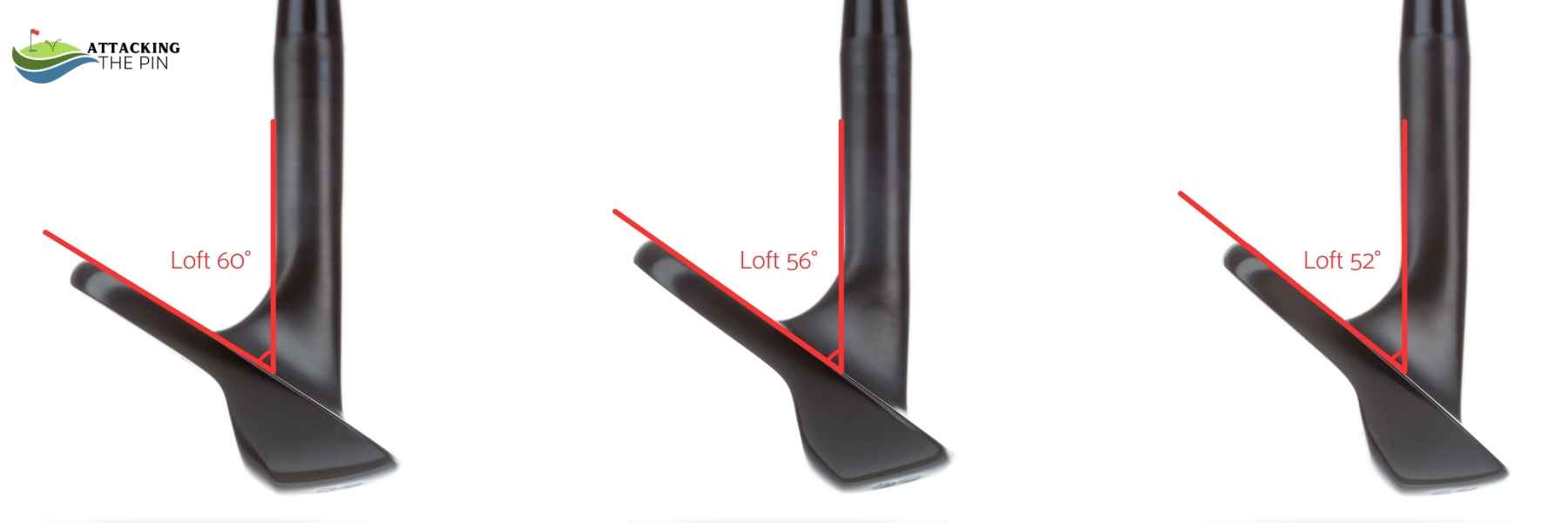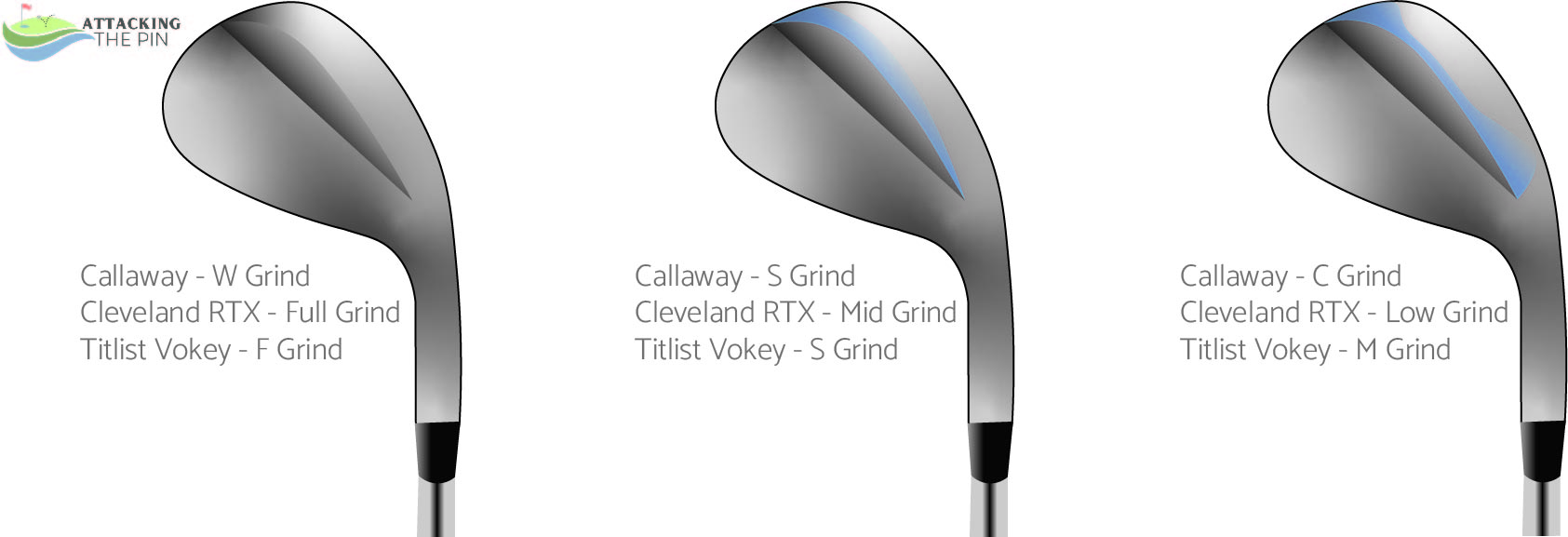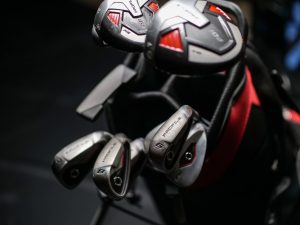I consider myself to be a pretty savvy golfer, but I soon had my head spinning as I started researching wedges. However, after hours spent reading articles and watching videos followed by a wedge fitting with a club fitting professional, I am now feeling more confident in explaining how to best stock your bag with wedges.
There are three key terms that we have to wrap our brains around as we dive into the world of wedges:
- Loft
- Bounce
- Grind
Don’t worry, we’ll walk through each of these terms and soon you’ll be able to talk wedges like a pro. Picking out wedges can be intimidating but by the end of this article you’ll have at least an easier time figuring out which you should be adding to, or taking out of, your bag.
What Wedge Options Do I Have?
Wedges have 3 primary characteristics: loft, bounce, and grind. Loft largely determines the distance, bounce determines forgiveness and playability, and grind helps fit the wedge to your swing and play style.
Wedges are often denoted in the following manner: Loft.Bounce Grind. For instance, a 56 degree wedge with a 10 degree bounce and a M grind would be labeled 56.10M. Now that you know what you’re reading, let’s jump into what loft, bounce, and grind really mean.
What Wedge Lofts Should I Carry?
Loft angle is typically the most important factor when selecting which wedges to carry. Loft angles for wedges range from 44-64 degrees with some specialty wedges having loft angles of 70 degrees or more.
Wedges are commonly split into 4 general categories by loft:
- Pitching wedge (44-48 degrees)
- Gap wedge (48-54 degrees)
- Sand wedge (54-58 degrees)
- Lob wedge (58-64 degrees)

You do not need to carry all four, or even three of these wedges. Which wedges you carry should be based on your needs on the golf course and your style of play. In order to determine what loft wedges and how many you want to carry you should answer the following questions:
- What gaps in yardage am I looking to fill?
- How many spaces in the bag can I afford to fill with wedges?
What Gaps Do I Need to Fill?
When determining what wedges to carry, the first question is what gaps in distance do you need to fill. Loft of the wedge will largely determine the ball flight and distance of the wedge. Clubs should be spaced approximately 10-20 yards between clubs so that you can easily pick a club for any distance to your desired target. Obviously, the closer together the distances are, the better. However, with a limited number of clubs in the bag, it can be hard to minimize completely. For example, I currently carry 4 wedges in my bag:
- Pitching wedge – 44 degree – I hit this club 125 yds
- Gap wedge – 52 degree – I hit this club 105 yds
- Sand wedge – 56 degree – I hit this club 88 yds
- Lob wedge – 60 degree – I hit this club 75 yds
As you can see, my gaps are on the higher side of the 10-20 yard recommendation. This is the result of the fact that I had no real strategy in assembling my set. I figured that I needed one of each wedge and that’s about as far as I got. It didn’t take much research to realize there’s a better approach to assembling my wedge set.
While distances by loft are going to different for each golfer, here’s a chart with average distances based on loft of the wedge:
To determine the gaps you are trying to fill, start with the highest lofted club (9-iron or pitching/gap wedge if your iron set contains one) and add 4-6 degrees for your first wedge you will be adding. Where possible, you should test different wedge lofts to determine what degree difference achieves your target gap.
One of the best ways to determine what wedges you need is to get fitted for wedges by a professional. Not only can they help you do a gap analysis, but they can also help you determine other important factors such as bounce and grind appropriate for your swing type.
How Many Wedges Should I Carry?
Count the number of clubs in your bag, including your driver, fairway woods, hybrids, irons, and putter, to determine the number of wedges you can carry. Golf rules only allow for 14 clubs in a bag at a time, so if you already have 13 clubs, there is only space for one wedge.
Typical wedge configurations include a two-wedge, a three-wedge, and a four-wedge setup. Golfers who typically hit further will carry more wedges as the majority of their second or third shots are being hit with a wedge.
Two-Wedge Setup
If you hit the ball shorter distances, it may be worth sacrificing some of the wedges in your bag for an extra fairway wood or hybrid. Another reason to go with a two-wedge setup is that you have an additional club you want to carry and feel comfortable adjusting your swing, or the face of the club, to fit the needs of the shot.
A typical two-wedge setup would be a 48-degree pitching wedge and a 56-degree sand wedge. This provides the needed loft for sand shots and basic flop shots but does require a ¾ or ½ swing or opening up the face and your stance with the 48-degree wedge to hit shots that fall in the gap between the two wedges.
Also, this kind of wedge setup may leave a large gap between your 9-iron and your pitching wedge. Using my bag as an example, I would have a nine-degree gap between my 9-iron and pitching wedge. I don’t feel comfortable taking that much off my 9-iron to accommodate shots outside the range of a 48-degree wedge. If I were using a two-wedge setup, I would probably go more towards a 46-degree PW and 54-degree SW combo. When picking your wedges, be intentional in the gaps you are leaving, considering the shots required to fill those gaps.
Three-Wedge Setup
This setup is where you can really start using wedges to fill gaps in your bag. Using the example above, you would simply add a 50 or 52-degree gap wedge depending on the loft of your pitching and sand wedge. This allows you to basically always hit a full pitching wedge or a full gap wedge and then adjust your sand wedge shots as you get closer to the green.
Four-Wedge Setup
This is the most common wedge configuration for professional golfers because they need the most shot creation options within 150 yds of the green. There are two options for the 4th wedge; you can either fill in the gaps or add loft to your setup.
Up until two months ago, I was playing a three-wedge setup:
PW – 44 degrees
GW – 52 degrees
SW – 56 degrees
My options with this setup would be to add a lob wedge to my bag or fill in the 8-degree gap between my pitching and gap wedge. I decided to add a lob wedge simply because I had never carried a lob wedge, and I found a cheap lob wedge which gave me a low-risk opportunity to try it.
I really enjoy the lob wedge, but in retrospect, I think a 48-degree wedge would have been a better choice so that I don’t have to take as much off my pitching wedge to fill the gap.
What is Wedge Bounce?
If you’ve heard people talking about the bounce on their wedges and have no clue what it means, you’re not alone. It’s not something that most casual golfers understand. Bounce is the angle difference between the ground and the leading edge of the club.

Bounce angle determines how forgiving the wedge is because a higher bounce prevents the leading edge from grabbing into the turf. The more bounce you have, the more forgiving your wedges will be.
However, the increased bounce does come with some loss of playability. For example, if you open your face to increase loft and have a high bounce, it will elevate the leading edge off the ground, increasing the chance of skulling the shot.
High vs. Mid vs. Low Bounce
High
A high bounce is anything over 10 degrees. Playing a wedge with this bounce angle will benefit players with a steeper swing and those who typically play in softer turf conditions. These clubs offer a high level of forgiveness on your shots but make it difficult to adjust the club’s loft by either adjusting wrist position at address or opening the club’s face.
Mid
Mid-bounce wedges have a bounce angle of 8-10 degrees. A 10-degree bounce is standard and what I have on all my higher wedges. My PW is a hybrid club with a very high bounce. Clubs with this range of bounce still offer excellent forgiveness but also allow for some shot manipulation. If, based on your gapping, you only plan to hit full swings with a wedge (like I do with my gap wedge), you shouldn’t drop below an 8-degree bounce and will probably be happier with a 10-degree or higher.
Low
Low bounce (below 8 degrees) wedges offer the greatest shot-making ability but are also the most difficult to hit consistently. Unless you have a sweeping swing or have specific shots you’re trying to hit, you’re better staying away from these wedges. You’ll generally only see lower bounce angles used in sand and lob wedges, although even among the pros, it’s uncommon to see bounce angles below 8. Unless you have been fitted by a professional for wedges with this bounce angle, I would recommend steering clear
A final word on Bounce
According to an article published by golfingfocus.com looking at 100 PGA tour golfers’ wedges, the most common bounce is 10 degrees for all clubs except the lob wedge for which 8-degree and 4-degree wedges were slightly more common. If you have any doubt on selecting bounce and don’t want to get fit for wedges, it’s hard to go wrong with a 10-degree bounce, or if you have a steeper swing angle and don’t intend to alter your shots, even a 12-degree bounce. Among the 100 tour players, 12-degree bounce was the second most common bounce angle for the gap wedge.
What is Grind on a Wedge?
Grind is a relatively new element when it comes to wedge selection. Each company has a different grind nomenclature making it challenging to write a comprehensive guide on grind, but essentially there are three grind patterns:
- Full – no grind (F in Vokey)
- Straight – the bounce is ground in a straight line along the trailing edge (S in Vokey)
- Curved – the bounce is ground more at the heel and toe of the club. (M in Vokey)
**Wedge Grinds JPG**

Due to the popularity and pioneering nature of Vokey wedges, I’ll use their system to explain how grind works. Grind on a wedge is intended to improve the playability of the wedge based on the play style of the golfer.
F Grind – Should be used primarily in clubs you only intend to hit with a full swing.
S Grind – Used by players who alter the loft of their club by changing their wrist position at address. If you lean the shaft forward or backward to change the club loft, then this is the grind for you.
M Grind – Used by players who alter the loft of their club by opening or closing the face. The grind allows you to maintain bounce angle by rotating the club open or closed.
Grind is the last consideration that you should worry about when purchasing a club, especially for beginners through mid-handicappers. I would even venture to say that price should play a more critical role than grind for the average player. The nuances of grind will not make a significant difference for the average golfer, so the investment on an M-Grind Vokey is likely not worth it.
For example, I like to open and close the face of my sand wedge, so an M-Grind makes sense. That said, if I found a good deal on a used F- or S-Grind Vokey, I’d add it to my bag in a heartbeat. This is because I know that I’m just not good enough for the grind to make that much difference for me. I’d rather have the correct loft and bounce in a good quality wedge than pay significantly more to get an M-Grind.
Currently, Vokey offers six grinds. The three most used are F, S, and M, with L, D, and K grinds being mostly used by scratch golfers and pros. For a full description of the six types of grinds available on the Vokey wedges, check out this video.
What about Chippers?
Chippers are a unique club that resembles a putter but typically have 37 degrees of loft. The purpose of these clubs is to allow you to hit short-range chips using a swing resembling a putt. It allows players who consistently chuck or skull short shots to practice a more consistent swing with a club that will glide along the ground, significantly increasing the potential for consistently making good contact.
These clubs are great for players who aren’t confident in their ability to hit chips close, but they do limit your options if you have to chip over a hill or bunker. The biggest downside to carrying a chipper is that it comes at the expense of some other club that you can carry in your bag. Typically that will be your highest lofted wedge. So if you are struggling to hit a 60-degree wedge well around the greens, it might be worth taking it out of the bag and replacing it with a chipper.
I don’t use a chipper but one tip I read for selecting a chipper is to pick one that most closely resembles your putter. This will allow you to use the same alignment methods and make consistent strokes with your chipper and your putter.
What wedges should I carry? – Final Thoughts
Ultimately the question will largely be up to you based on your needs on the golf course and your budget. If I were making a recommendation for beginners through upper mid-handicap players, I would suggest a three-wedge setup with something like the following:
- PW – 46.10F
- GW – 50.10S
- SW – 56.10S
Again, the grinds are merely suggestions, and any grind should work just great for most golfers. This three-wedge setup will allow you to add a 5- wood or an extra hybrid, or even a chipper to your bag. As your game progresses, you may want to move to a 4-wedge setup.
Once your game is ready to really benefit from dialing in your wedge set, I would strongly suggest that you get fitted for wedges if possible. At the time I’m writing this, fitting for wedges at Golf Galaxy or Dick’s costs $80. If you happen to live near a PGA Tour Superstore, they will fit you for any club free of charge.
Getting some feedback and trying out some different wedge configurations will help clarify what you want to be carrying in your bag.
What Other Clubs Should I Have In My Bag?
Of course, wedges are only part of the story. Check out our post titled “What Clubs Should I Have In My Bag” to learn more about what clubs you should be carrying.
If you’re looking for our recommendations on wedges they can be found here based on your player profile
- Beginner
- High Handicap
- Mid Handicap
- Women
- Senior






